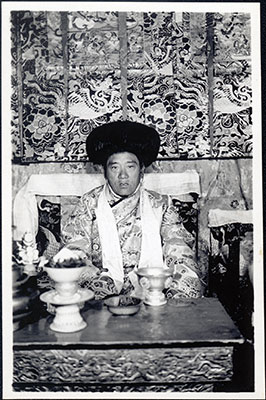
1998.131.471.1 (Contact Print)


1998.131.471.1 (Contact Print)

Frederick Spencer Chapman
Frederick Spencer Chapman
February 14th 1937
Lhasa > Tsarong House
1998.131.471.1
88 x 58 mm
Ritual Activity
Print gelatin silver
Donated 1994
Faith Spencer Chapman
British Diplomatic Mission to Lhasa 1936-37
Frederick Spencer Chapman
B.5 [view film roll]
SC.T.2.471
Notes on print/mount - The contact print has been made using Velox paper as the trade mark has been printed on the back, enclosed within an oval. The number '640' has been printed on the back of the print in red ink [MS 30/6/2005]
Manual Catalogues - Caption in Chapman's hand-written list of negatives made whilst on the Mission to Lhasa, 1936-7 [See PRM Manuscripts Collection]: '1/4 Tsarong at home ceremony'; PRM Manuscripts Collection: ‘List of Tibetan Prints and Negatives’ - Book 3: ‘12/5 - Tsarong wearing scarf hung round his neck by his steward’ [MS 27/03/2006]
Other Information - Related Images: This photograph is that referenced as 'B5' in Chapman's handlist of negatives made whilst in Lhasa. Images prefixed with 'B' seem to have been taken during the New Year ceremonies in 1937 [MS 27/03/2006]
Other Information - Dress: Tsarong is shown wearing the dress of a high official at the New Year ceremony in 1936. The chuba (gown) is made from silk brocade with Chinese-style dragon motifs. His gold, turquoise and coral ‘sog byil’ (ear-ring) indicates that Tsarong was a high-ranking layman of the Tibetan government. A strict dress code applied at ceremonial occasions such as this and Tibetans were told what to wear depending on their status. Born into a peasant family, Nangang, took the name Dasang Damdul Tsarong when he married into an aristocratic family. He was a favourite of the 13th Dalai Lama and served both as a military leader and a member of the Tibetan government. [Clare Harris, 2003]
Biographical Information - Dasang Damdul Tsarong was a favourite of the 13th Dalai Lama, a military man and later a shappe (cabinet minister in the Tibetan government) until he was removed from office as a result of his modernising policies. He was a great friend of the British Mission frequently inviting them to his house and accompanying them on their various visits around Lhasa. He was considered by the mission to be a great character, as Gould recalled “Once, after a long and festive party at the De Kyi Lingka, he fell asleep in my arms murmuring, “Great minister, I love you, I love you”. At breakfast next morning he had his usual bright eye and was quite unperturbed. He spoke a little English. To him it seemed strange that anybody in India should not welcome British rule”. (1957:236) He had four wives (including Rigzin Choden, Pema Dolkar, Rinchen Dolma (later Mary Taring) and Tseten Dolkar) and ten children. Although he was in India in 1956 he insisted on going back to Tibet to help the Dalai Lama to escape into exile. He was captured by the Chinese and in 1959 died mysteriously the night before what was due to be his public humiliation. [CH 2003]
Other Information - Setting: Chapman wrote quite extended descriptions of the setting of this photograph in both the official Mission Diary of the 1936-37 Mission to Lhasa, for which he was responsible as Sir Basil Gould's Secretary and his main publication concerning his time in Tibet Lhasa the Holy City [London: Chatto & Windus, 1938; reprint London: Readers Union, 1940]. The accounts differ little, demonstrating how Chapman would sometimes lift sections from the diary for his publication. In the book, Chapman stated that it was customary on the third day of the Tibetan New Year for a domestic ceremony to be held in homes, and that Tsarong was very keen that the Mission party should come to see the occasion in his own house "and had made special arrangements so that I could take photographs by artificial light" [1940: 320]. However, Chapman wrote more fully of Tsarong's costume in the Mission Diary. He stated: "The master of the house takes his seat in the best room which contains the family altars before which are now set out the traditional New Year offerings: barley meal, butter ornaments, rice, fried cakes, ram's head fashioned in butter, and pots of green sprouting barley shoots. The master's seat is a canopied divan which varies in height with the rank and dignity of the owner. Besides him on his left sit his wife and children in all their best clothes. If he is of high rank the master will be wearing a robe of yellow silk patterned with Imperial five-clawed dragons, and a round flat hat of red silk heavily bordered with fur and topped by an ornament of gold turquoise and other semi-precious stones surmounted by a ruby or amethyst button - a survival of the Chinese buttons of rank" [Mission Diary for 14th February 1937]. The scarf would have been placed around Tsarong's neck when the ritual offerings of barley beer had been presented to him by the household. He would then have reciprocated to his family and servants [see 1940:320-22] [MS 30/6/2005]
For Citation use:
The Tibet Album.
"Tsarong in 'At Home' ceremony, New Year"
05 Dec. 2006. The Pitt Rivers Museum.
<http://tibet.prm.ox.ac.uk/photo_1998.131.471.1.html>.
For more information about photographic usage or to order prints, please visit the The Pitt Rivers Museum.
© The Pitt Rivers Museum